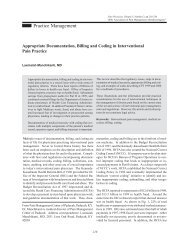ASIPP Practice Guidelines - Pain Physician
ASIPP Practice Guidelines - Pain Physician
ASIPP Practice Guidelines - Pain Physician
Create successful ePaper yourself
Turn your PDF publications into a flip-book with our unique Google optimized e-Paper software.
Manchikanti et al • <strong>ASIPP</strong> <strong>Practice</strong> <strong>Guidelines</strong><br />
63<br />
lief of pain was sustained at 6 and 12 months and was associated<br />
with improvement in disability, reduced drug use<br />
and a return to work rate of 53%. They concluded that in<br />
carefully selected cases, IDET can eliminate or dramatically<br />
reduce the pain of internal disc disruption in a substantial<br />
proportion of patients and appears to be superior<br />
to conventional conservative care for internal disc disruption,<br />
with a success rate as low as 23% or as high as 60%,<br />
with confidence intervals of + 16%.<br />
Wetzel et al (670) reported the preliminary results of a<br />
multicenter prospective cohort study of intradiscal electrothermal<br />
annuloplasty to treat discogenic low back pain.<br />
The study group included patients from centers in Chicago,<br />
Dallas, Plano, Roseland, and Syracuse. A total of<br />
78 patients were entered in the intent-to-treat group. The<br />
inclusion criteria were: complaint of predominantly low<br />
back pain, persistence of symptoms for greater than 3<br />
months, and failure of at least 6 weeks of conservative care.<br />
Exclusion criteria were: sequestered disc herniation, greater<br />
than two levels of symptomatic degenerative disc disease,<br />
spinal stenosis, spondylolisthesis or previous surgery at the<br />
treated level. Patients were reevaluated at 1 month, 3<br />
months, 6 months, and 1 year. There were eight withdrawals<br />
from the study. Seventy patients completed the study,<br />
with five failures, four who went to fusion, and one who<br />
received a second IDET. In all, 93 levels were treated in<br />
65 patients. Twenty-nine patients underwent two-level<br />
treatment and thirty-five underwent one-level treatment.<br />
They reported significant improvement in VAS scores,<br />
bodily pain, physical function, social function, reported<br />
health transitions, physical health and pain, treatment expectation,<br />
patient satisfaction and pain disability at 3, 6,<br />
and 12 months. Significant changes in a greater work ability<br />
were also seen at one year, along with improvement in ability<br />
to sit and walk. The initial failure rate was 6.9%; however,<br />
the authors have not described success rate with the<br />
number of patients.<br />
Saal and Saal (667), in a prospective case series, reviewed<br />
outcomes of 62 patients with unremitting chronic<br />
discogenic low back pain who were faced with a choice of<br />
long term pain management or fusion surgery. They treated<br />
these patients with IDET, with a mean follow-up of 16<br />
months, and mean preoperative duration of symptoms of<br />
60 months. They reported improvement in 70% of the<br />
patients, not only with physical pain but also with return to<br />
work. Saal and Saal (674) also reported their findings with<br />
a 2-year follow up. Outcome scores at 1-year follow up<br />
were not statistically different from outcome scores assessed<br />
at 2-year follow-up.<br />
Singh (668) published a preliminary report evaluating 23<br />
patients at 6 months with improvement in 70% of the patients.<br />
Derby et al (666) reported their findings of IDET<br />
in a 1-year pilot outcome study with 32 patients. They<br />
reported that 63% of the patients had a favorable outcome,<br />
with no change in outcome measures at 6-month and 12-<br />
month follow-ups. Derby and O’Neill (671) evaluated the<br />
effects of IDET on referred leg pain, reporting significant<br />
relief of referred leg pain. Even though the mechanism of<br />
relief is unknown, a reduction in the chemical sensitivity<br />
and reduction in inflammatory chemical substances in the<br />
outer annulus and adjacent epidural space are proposed to<br />
explain the results. Liu et al (675) attempted to identify<br />
factors associated with favorable outcomes in 50 patients<br />
treated with IDET. They reported overall favorable clinical<br />
results in 60% of the patients. They also reported that<br />
the results were less favorable with time decreasing to 43%<br />
at 12 months and 33% at 18 months. They concluded that<br />
the IDET procedure for degenerative discs achieved clinically<br />
favorable results in 60% of the patients. However,<br />
these results can be substantially improved by proper patient<br />
selection and careful attention to correct catheter placement.<br />
Predictive clinical factors included: age less than<br />
40; nonsmoker status; female sex; symptoms of less than 4<br />
years; modified Dallas type 1, 2, 3 annular tears; and perfect<br />
spine catheter placement along the entire posterior<br />
annulus. Maurer et al (673) investigated 36 consecutive<br />
patients in a prospective case series who underwent IDET.<br />
They reported that at six months, 94% of patients had a<br />
mean decrease of four points on VAS. Functional scales<br />
(sitting, standing, walking) increased on average 75%. Lee<br />
et al (675) evaluated the stability of the spine after<br />
intradiscal electrothermal therapy. This was an in vitro<br />
study to analyze whether or not there was any significant<br />
change in human cadaveric disc stability after IDET. Preliminary<br />
results of this study suggested that there is no significant<br />
difference in spine segmental stability before and<br />
after treatment with IDET in vitro.<br />
Based on the above reports which included two prospective<br />
evaluations and multiple observational studies, in terms<br />
of type and strength of efficacy evidence is type III – moderate,<br />
which is evidence from well-designed trials without<br />
randomization, single group prepost, cohort, time series,<br />
or matched case controlled studies complimented from<br />
well-designed non-experimental studies and also opinions<br />
<strong>Pain</strong> <strong>Physician</strong> Vol. 4, No. 1, 2001
















